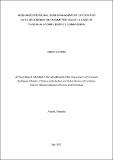Web-based personal dose management system for data recording on dosimeter usage: a case of Tanzania atomic energy commission
Abstract
Modern technology drives the world, increasing performance while reducing labour and time
expenses. Tanzania Atomic Energy Commission (TAEC) tracks employees’ levels of
exposure to radiation sources using dosimeters. According to legal compliance, workers wear
dosimeters for three months and one month at the workplace. However, TAEC has problems
in tracking, issuing, and returning dosimeters because the existing tracking is done manually.
The study intended to develop a Personal Dose Management System (PDMS) that processes
and manages the data collected by dosimeters for easy and accurate records. During the
requirements elicitation process, the study looked at the existing system. PDMS’ requirement
gathering included document reviews, user interviews, and focused group discussions.
Development and testing of the system were implemented by applying the evolutionary
prototyping technique. The system provides a login interface for system administrators,
radiation officers, and Occupational Exposed Workers. The PDMS grants TAEC Staff access
to monitor individual exposed workers, prints individual and institutional reports and
manages workers' information. The system reminds the users when to return dosimeters to
TAEC, generates reports, and facilitates dispatching and receiving dosimeters effectively.
PDMS increases efficiency and effectiveness while minimizing workload, paperwork, and
inaccurate records. Although the existing systems are beneficial to their respective countries,
they are designed based on the specific institution. The system developed simplifies the
procedures for requesting dosimeters, reminding users when to return the dosimeter, and
printing quarterly and annual reports for individuals and institutions. Therefore, based on the
results obtained from the system, it is recommended to use the system to improve dosimeter
data management at the institution.

